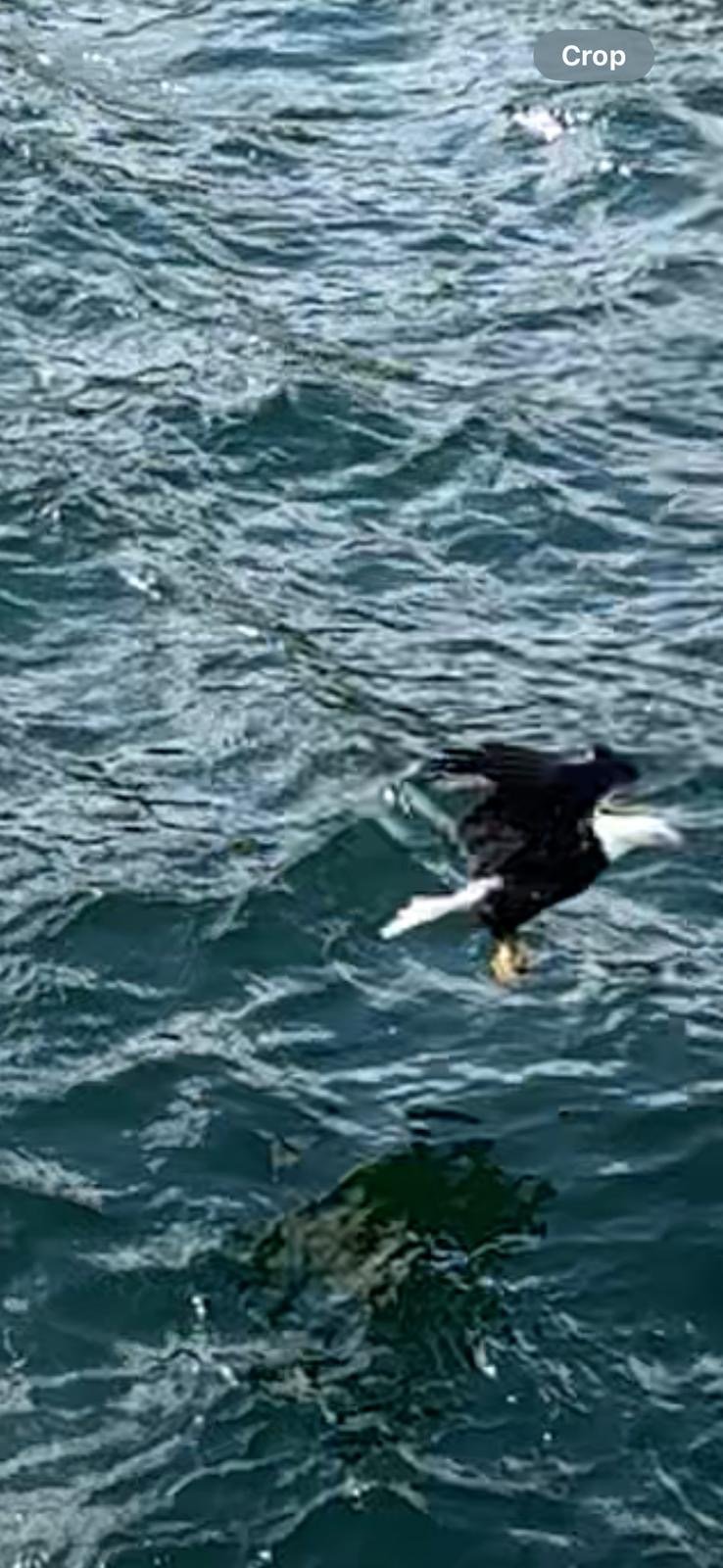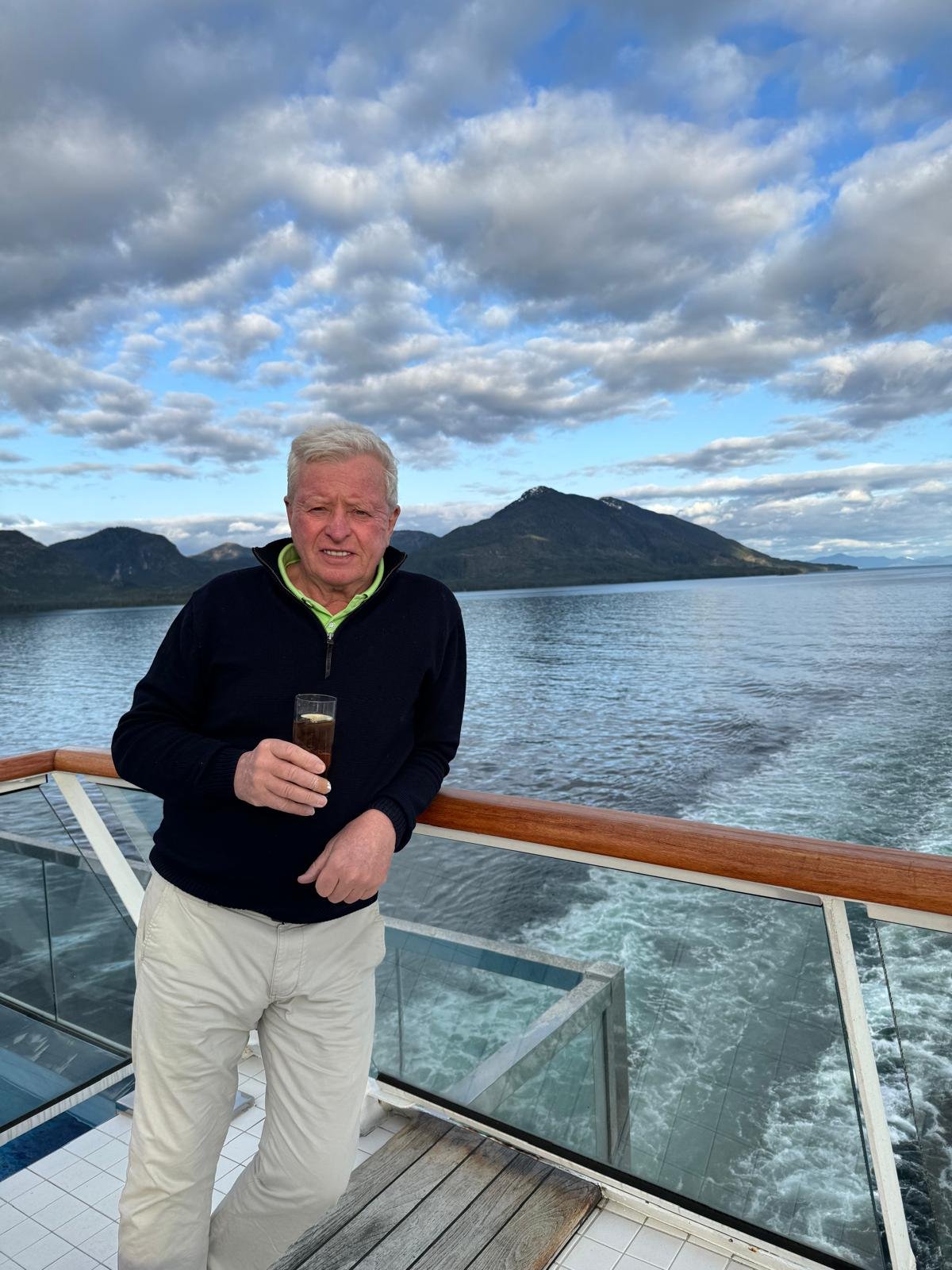Alaska’s Inside Passage
Wednesday 15 May
We left Vancouver last night on a very lovely, sunny evening – made even more celebratory because we were joined by good friends Jo and Earl, who left Auckland a few days after us, and met up with us in the two-hour queue to get through US Customs (not the best start, but there was also another much bigger cruise ship departing at the same time, which added about another 3,000 passengers to the queue!).
It’s our first cruise day and we are sailing up Alaska’s Inside Passage to our first stop, Ketchikan. The Inside Passage was shaped by the staggering force of massive glaciers millions of years ago and stretches 500 miles along the Pacific Ocean. It boasts wildlife-filled fjords, tidewater glaciers and lush island scenery. It is home to Tlingit, Haida and Tsimshian Alaska Native peoples whose history is reflected in towering totem poles (more of that after we have visited some of them tomorrow!) and whose vibrant culture can be seen through art, song, and dance. Russian settlers have also left their legacy with their onion-domed churches filled with priceless treasures.
We’ll be visiting Ketchikan, Sitka, Juneau, Skagway, sailing across Glacier Bay and Yakutat Bay, Valdez and disembarking in Seward. We’ve been promised plenty of adventure – culture, glacier viewing, whales, bears and eagles, not to mention fishing and kayaking for Geoff, Earl and Jo, but not for me – never kayaked before so don’t think my first attempt at it should be in these freezing waters! I have chosen some much tamer excursions!
Sadly, the sunshine of yesterday has disappeared and we awoke this morning to grey misty skies and sea, so it’s a bit of a monochrome view out of our cabin at the moment, but hopefully not for long. In the meantime, we have been enjoying the luxurious comforts of our Viking Orion Ship, a bit like coming home for Geoff and I after our Mumbai to Athens cruise on its sister ship, the Viking Mars, last year. So don’t feel too sorry for us, it’s not all bad!!!
Thursday 16 May
A glorious sunny day today (apparently the first one in the last 4 days!) so we are very fortunate as we have a big schedule. We docked in Ketchikan at 10.00am and wasted no time in getting off the boat to have a look around the town before our various tours start at lunchtime. Ketchikan is an island with a population of 8,000 people,15,000 black bears, and is known as both the salmon capital of the world and the rain capital of Alaska. It is located on Revillagigedo Island, named in 1793 by Captain George Vancouver after Ketchikan Creek which flows though the town emptying into the Tongass Narrows a short distance southeast of its downtown. It comes from the Tlingit name for the creek, Kitschk-hin, meaning “Thundering Wings of an Eagle. It also has the world’s largest collection of standing totem poles….more of that later.
Ketchikan’s economy has been based on fishing industries, canneries and tourism. Five varieties of salmon are resident in these waters: king (chinook), coho (silver), pink (humpy), sockeye (red) and chum (dog) salmon. The area near the mouth of Ketchican Creek also earned Ketchikan a measure of infamy during the first half of the 20th Century for its red light district known as Creek Street, with brothels aligned on either side of the creek.
Merino-ed up, we headed off in the brisk wind into the town centre to explore and had the most wonderful walk through Creek Street. This historic boardwalk is perched on pilings along the banks of the Ketchikan Creek - a former Red-light district where both men and salmon swam upstream to spawn! And it was great walking down it and exploring the little shops showcasing local art and culture. During its heyday of Dolly Arthur and other sporting women of this famous Street, police raids on brothels were frequent!
Then it was back to the boat as we had two tours booked for the afternoon, Jo and I on the tour of the totem poles and Geoff and Earl on the Sail with the Bering Sea Fisherman.
Update on the fishing trip from Geoff….”we embarked on the fishing boat which is the star of the Discovery Channel’s “Deadliest Catch” programme. The vessel is now converted for tours by setting up an arena of seats around half the width of the boat looking into a work area where the fisherman showed us how they caught lobster and worked their longlines. The crab process was pretty straightforward, they hooked the buoys, put the pull line on an electric pulley and zoomed the pot to the surface (250 metres deep). It certainly would have been a lot harder back in the day when it was done by hand in the freezing conditions of Alaska in the Winter. The pot contained several king crabs and some snow crabs, the king crab is much larger than the snow crab. Interesting fact is that the king crab population has diminished enormously as a result of the schools of cod coming south of the Aleutian islands and into the areas around Kodiak island which was previously reputed to be the lucrative area to fish king crab, and the crab there now are almost extinct as a result of the cod eating the crabs.
As we moved on to the next location, they showed us the circular hooks they used on their longlines which they baited and prepared to be launched. We retrieved a previously laid longline which again had an electric winch which made things quite easy to bring up from the deep. We pulled in two rockfish (about 37cms each) which were kept for bait; a halibut which was undersized, and after being shown to us, was returned to the sea, and a snake fish which was probably two metres long with a mouth and jaw wide and strong, which the fisherman said was a very dangerous fish to have aboard and having shown us this in close quarters, thankfully returned it to the sea! We then laid the previously baited longline, headed for another crab pot, then headed back to Ketchikan. On the way back we pulled in by a little promontory and the crew threw herring into the air, and out of nowhere, bald-headed eagles appeared to catch the herring. They were amazing, they are the national bird of the USA and have a wingspan of up to 7 ½ feet and hugely powerful talons, and they caught these fish in mid-air with their talons,. If the fish lands in the water, they swoop down and grab it, not in their beaks like other seabirds, but pluck it out of the water as they glide above it. It was an interesting trip, we learned of the lives of the fisherman, saw how they caught their fish and watched the video of this particular boat being knocked flat by a 60 foot wave when it was in the business of catching crab some years ago. The boat survived this knock down because at the time, its hull was full of tons of crab which assisted in righting the boat. It was a pleasant day, a chilly breeze, but we were able to shelter from the wind assisted by hot coffee, cocoa and crab!” Thanks Geoff!
Jo and I were booked on a tour to Potlatch Totem Park, a modern recreation of a 19th century native village, located on historic Tlingit fishing grounds along the shores of the Tongrass Narrows. Totem poles are monuments created to represent and commemorate ancestry, histories, people or significant events and to proclaim the lineage and social standing of their owners. They are mainly carved out of red cedar which is abundant in the Pacific Northwest, and a good number of them referenced eagles, fish, ravens, mythical creatures and the members of a particular family. They have great cultural importance and significance. We were also able to experience Native clan houses and see what life was like 200 years ago. The clan houses are traditional hand-adzed cedar plank style and feature elaborate carvings painted mainly in red, turquoise, black and white from the minerals - iron ore, copper oxide, charcoal and the white from clam shells.
A great day was had by all of us and we returned to the boat and took advantage of a glorious sunny evening by having a cocktail in the outside spa as we slowly drifted out of the harbour enroute to our next stop, Sitka.





























